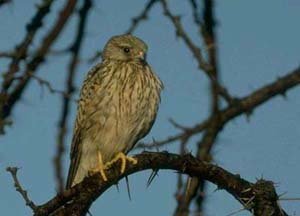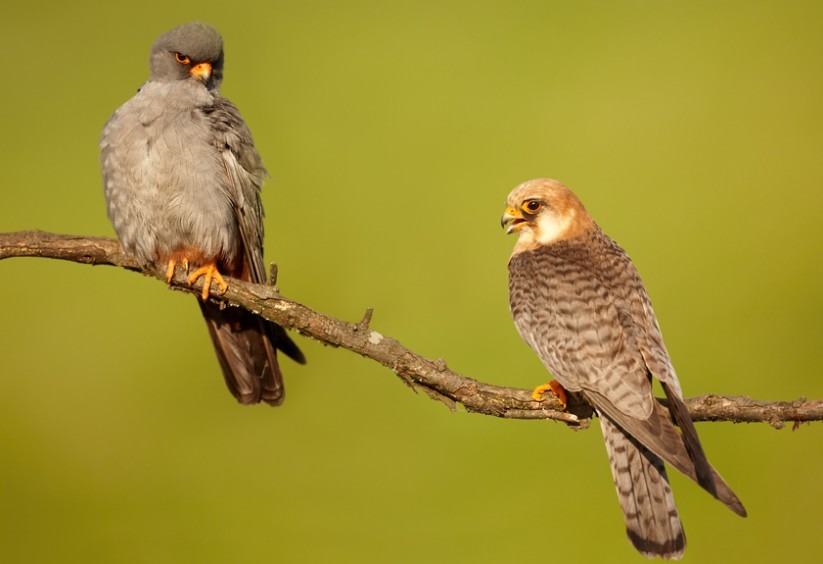It is a small falcon, whose adult males sport a sooty-gray plumage with reddish-brown to orange vent and thighs. Females have subtler gray upperparts, while the underside is white, marked with darkish “V” marks. It is recognizable from its falcon cousins through its red-orange cere, eyering, and feet. A resilient migrant, it travels from eastern Siberia and Northern China, passing and aggregating in India, before spending the winter in Southern Africa.
Read further to know more about the Amur Falcon.
What is an Amur Falcon?
Amur Falcon (Falco amurensis), also known as the Manchurian Falcon, Eastern Red-footed Kestrel, or the Red-legged Falcon, is a small raptor species belonging to the family Falconidae. It was initially regarded as a genetic mutation or subspecies of the Red-Footed Falcon (Falco vespertinus) but is now deemed a unique and separate species.
Its seven levels of classification are as follows:
Kingdom: Animalia
Phylum: Chordata
Class: Aves
Order: Falconiformes
Family: Falconidae
Genus: Falco
Species: F. amurensis
Amur Falcon Physical Description
Amur Falcon is a small migratory falcon, growing from 11.8 to 14.1 inches, and weighing from 97 to 188 grams, with a wingspan of 25.5 to 29.5 inches or 65 to 75 centimeters.
Adult males have a mostly sooty-gray plumage, reddish-brown to orange vent and thighs, and white underwing. The bill is hooked, accentuated by an orange-red cere. An orange-red eyering circles the dark brown eyes. Short, bare legs and feet also have an orange-red tone. Meanwhile, females have subtler gray upperparts, with dark gray bars. The underside is whitish, with darkish “V” marks. Both flight and tail feathers are darkish gray, with light gray bars, and white bars below. Juveniles are similar to the female but relatively browner, with buff edgings on the feathers, and dull orange cere, legs, and feet.
Where can they be spotted?
Amur Falcons breeds in south-eastern Siberia and northern China while wintering in southern Africa. They leave their Asian breeding grounds from August-September, congregate and roost and India before arriving in southern Africa in November, completing an estimated 11,000-kilometer trip. Its African range includes Botswana, Zambia, Zimbabwe, Mozambique, Namibia, and South Africa, preferring open, moist savannas, woodlands, grasslands, and croplands.
Interesting Facts You Should Know About the Amur Falcon
Amur Falcons feed early in the morning or late in the evening, consuming arthropods, grasshoppers, locusts, beetles, bees, termites. They catch most of their prey while on the wings, sometimes hovering or alighting from a perch on the ground. These birds may also dive into large swarms of insects, such as the emergence of termite alates.
In their breeding range, they may also take small amphibians, birds, and mammals to feed their offspring. Meanwhile, dragonflies serve as their source of food, when taking breaks and congregating in regions part of their long, tiring migration route.
The breeding season happens from May to June, where several pairs can be seen nesting near each other. Nest can be tree cavities or platforms abandoned by other birds. The female lays a clutch of 3 to 4 eggs, with intervals of two days. Both sexes share the incubation duties for about 28 to 30 days. After hatching, both parents will feed the broods, which will leave the nest after another 30 days.
Amur Falcons have a vast breeding range and relatively large population size, resulting in the species being evaluated as Least Concern (LC) under the IUCN Red List of Threatened Species. However, their flocking behavior during their migration and passage, makes them vulnerable to hunting. In their stopover site in India, these birds’ mass trapping has been reported and exposed to the media. Now, several campaigns have begun to protect the species.
WILDLIFE PARKS AND RESERVES WHERE THIS SPECIES IS FOUND:
BOTSWANA
SOUTH AFRICA
NAMIBIA
ZAMBIA
ZIMBABWE
BOTSWANA BIRDS | SOUTH AFRICA BIRDS
NAMIBIA BIRDS | ZAMBIA BIRDS | ZIMBABWE BIRDS


